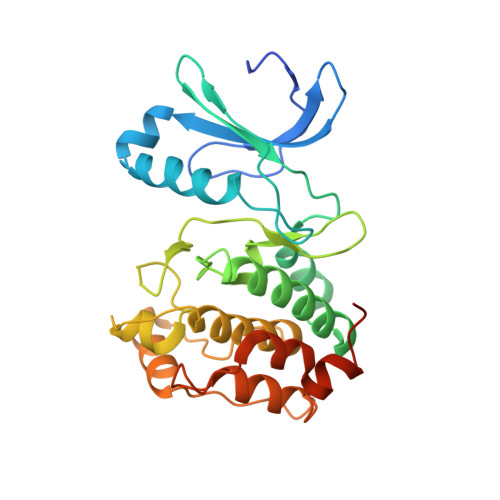Crystal Structure of an Aurora-A Mutant that Mimics Aurora-B Bound to Mln8054: Insights Into Selectivity and Drug Design.
Dodson, C.A., Kosmopoulou, M., Richards, M.W., Atrash, B., Bavetsias, V., Blagg, J., Bayliss, R.(2010) Biochem J 427: 19
- PubMed: 20067443
- DOI: https://doi.org/10.1042/BJ20091530
- Primary Citation of Related Structures:
2WTV, 2WTW - PubMed Abstract:
The production of selective protein kinase inhibitors is often frustrated by the similarity of the enzyme active sites. For this reason, it is challenging to design inhibitors that discriminate between the three Aurora kinases, which are important targets in cancer drug discovery. We have used a triple-point mutant of Aurora-A (AurAx3) which mimics the active site of Aurora-B to investigate the structural basis of MLN8054 selectivity. The bias toward Aurora-A inhibition by MLN8054 is fully recapitulated by AurAx3 in vitro. X-ray crystal structures of the complex suggest that the basis for the discrimination is electrostatic repulsion due to the T217E substitution, which we have confirmed using a single-point mutant. The activation loop of Aurora-A in the AurAx3-MLN8054 complex exhibits an unusual conformation in which Asp274 and Phe275 side chains point into the interior of the protein. There is to our knowledge no documented precedent for this conformation, which we have termed DFG-up. The sequence requirements of the DFG-up conformation suggest that it might be accessible to only a fraction of kinases. MLN8054 thus circumvents the problem of highly homologous active sites. Binding of MLN8054 to Aurora-A switches the character of a pocket within the active site from polar to a hydrophobic pocket, similar to what is observed in the structure of Aurora-A bound to a compound that induces DFG-out. We propose that targeting this pocket may be a productive route in the design of selective kinase inhibitors and describe the structural basis for the rational design of these compounds.
Organizational Affiliation:
Section of Structural Biology, The Institute of Cancer Research, Chester Beatty Laboratories, 237 Fulham Road, London SW36JB, U.K.















